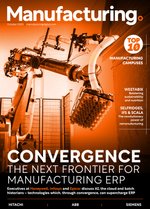Siemens: Inventing the Future With the Industrial Metaverse

The industrial revolutions of the past were rapid, but the one we are experiencing today is even faster.
“During the 4th industrial revolution, pioneers and industry leaders have deployed technologies such as IIOT at scale to gain competitive advantage,” says Ajithkumar Nandakumar, Vice President of Global Strategic Delivery Initiatives, IoT Practice at Hitachi Digital Services.
“They have realised benefits such as increased throughput, reduced downtime, greater energy efficiency, more responsive supply chains and safer operations.”
Continuous innovation is the name of the game with Industry 4.0, introducing a menagerie of innovations that are boosting productivity, efficiency and competitiveness.
But it is just the start. Another, even bigger, technological revolution is fast approaching.
“Today, we are at the cusp of the 5th industrial revolution that is ushering the cognitive era into manufacturing,” Ajithkumar says.
“As a result, manufacturers who have invested in IIoT will have the edge to harness the data and insights to create new revenue streams and innovative business models.
“They will further embed intelligence into their products and look to increase the lifetime value of their customers.”
Core to the 5th industrial revolution is what has been termed the ‘Industrial metaverse’, where immersive technologies will revolutionise engineering, design, testing and training.
A leader in this concept is Siemens, the German multinational technology conglomerate and manufacturing giant. With an annual revenue in 2023 of US$83.1bn, a 6.5% increase from 2022, the company’s stake in the industrial metaverse is fuelling profit and growth, as elaborated upon at CES 2024 by CEO Roland Busch.
“We envision the industrial metaverse as a virtual world that is nearly indistinguishable from reality, enabling people — along with AI — to collaborate in real-time to address real-world challenges,” he said.
“This will empower customers to accelerate innovation, enhance sustainability and adopt new technologies faster and at scale, leading to a profound transformation of entire industries and our everyday lives.”
Siemens’s investment in the industrial metaverse has been profound, through solutions like the Siemens Xcelerator Ecosystem, Comos Walkinside and the Omnifactory.
Virtual training in the industrial metaverse
Mistakes on the factory floor matter a lot. They can create substantial financial losses through downtime, or in worst-case scenarios lead to life-changing injuries.
Operators must be equipped with the best training possible, reducing the risk of errors and empowering them to respond quickly in emergencies. The best training right now for manufacturers is arguably virtual training.
“In the industrial metaverse, virtual training bridges the gap between the physical and digital worlds, creating a seamless environment for training, collaboration, and innovation,” Says Bart Moors, General Manager Process Industries Software, Siemens AG.
“Virtual training allows for the simulation of entire production lines, complex machinery operations and emergency response scenarios.
“This integration within the industrial metaverse facilitates continuous learning and real-time updates, ensuring that employees are always equipped with the latest knowledge, skills and competencies.”
“Furthermore, it promotes a culture of innovation by enabling employees to experiment with new ideas and processes in a risk-free virtual space.”
Siemens is the only company globally to offer a software platform for the integrated management of plant projects, called COMOS. This fully-integrated platform features an enterprise server, interactive web portal and COMOS Walkinside.
COMOS Walkinside is a powerful visualisation tool that uses data to simulate a 3D virtual environment of manufacturing plants. Employees can virtually walk through plants, gaining comprehensive insights into their efficiency, productivity and safety.
“Users can perform virtual inspections, maintenance procedures and safety drills, all within a highly accurate digital replica of their facility,” explains Bart.
“In addition, the virtual environment can be utilised for emergency and HSE-related training. COMOS Walkinside helps improve operational efficiency by enabling better preparation and planning, reducing downtime and minimising the risk of human error.”
With the power of simulation, operators can even familiarise themselves with plants that have not yet been built and tap into the powerful benefits of VR training.
PwC's study 'Seeing Is Believing' found that virtual learning is the most cost-effective way of learning when done on a large scale. The v-learners completed training four times faster and were four times more focused than their e-learning peers.
After training in VR, 40% of the v-learners saw a 35% improvement over e-learners when it came to acting on what they had learned.
The Benefits of VR Training
-
Safer and cost-effective : A controlled environment lacking real-world risks and costs
-
Interactive and immersive: A hands-on experience without distractions
-
Customisable: Programmes can be tailored to roles, machinery and procedures
-
Flexible and accessible: Can be conducted remotely at any time
Virtual reality training will also help attract future talent, according to Bart. With the World Economic Forum predicting a shortage of over 7 million skilled manufacturing workers by 2030, this talent is greatly needed.
“For attracting new talent, especially younger generations who are tech-savvy and accustomed to digital experiences, VR training presents the industry as forward-thinking and innovative,” he says.
“It demonstrates a commitment to cutting-edge technology and continuous learning, making the manufacturing sector more appealing. Additionally, the flexibility and accessibility of VR training can draw individuals from diverse backgrounds, broadening the talent pool and fostering a more inclusive workforce.”
VR training also enhances the upskilling process and increases the accessibility of specialist manufacturing knowledge, helping to achieve the vital task of plugging manufacturing’s knowledge retention gap.
“Today’s mobile generation of workers are more likely to jump between different companies and process areas, so it's highly important that we plug the knowledge retention gap that this can leave in a business,” says Sanjit Shewale, Global Head of Digital Business Line, ABB Process Industries Division.
“Equipping human operators with the skills to work with autonomous technology is essential to continuously evolve the AI/ML models that have been built using the invaluable human knowledge embedded within them. Arming workers with these skills in the digital age is not a matter of choice: it’s a necessity.”
Siemens shares this perspective, leveraging VR technology to drive broader industry digital transformation.
“Siemens's commitment to integrating advanced technologies into its training programmes underscores its dedication to future-proofing the industry,” says Bart.
Another way the company is future-proofing the industry and embracing the digital metaverse is through reimagining the factory itself with the Omnifactory.
The impact of the Omnifactory
There’s plenty of talk in the manufacturing sector about the ‘factory of the future’. But what’s often missed in these discussions is the need for a fundamental rehaul of how we conceptualise, build and expand factory operations.
Industry 4.0 is being implemented into a foundation designed for the manufacturing needs of the late 20th century – not a factory designed with today's supply chain unpredictability, ebbing and flowing demand and digital transformation in mind.
Siemens has said it is time for a redesign, with the Omnifactory, a holistic factory of the future that advances the importance of the industrial metaverse.
“The Omnifactory is a five-year project at the University of Nottingham which comprises hardware from multiple sources connected on a backbone of Siemens hardware and software to create a step-change in manufacturing for companies large and small,” says Bart.
“It represents a next-generation manufacturing environment where digital and physical worlds converge, enabling a fully integrated, smart production ecosystem.
“This initiative showcases advanced technologies such as IoT, AI, and digital twins, highlighting Siemens's commitment to innovation and excellence in manufacturing.”
As consumer demand for personalisation grows, the Omnifactory helps manufacturers transition from the traditional factory focus of high volume and low complexity to prioritising flexibility.
Using the Siemens Xcelerator portfolio, a digital twin of the manufacturing process is generated, optimising operations, eliminating waste and lessening the demands of testing through ‘virtual commissioning’. With digital twins, prototypes are unnecessary.
Additionally, the Omnifactory is furthering student research and understanding of manufacturing, something which Siemens also seeks to do through its comprehensive micro-credential programmes.
“Through micro-credential programmes, Siemens offers targeted, specialised training that allows employees to gain specific skills and certifications,” Mark explains.
“Partners for this include the University of Colorado Boulder and Pennsylvania State University. These programmes are designed to be flexible and accessible, accommodating the varied needs of the modern workforce.”
“By providing these opportunities, Siemens not only upskills its current employees but also attracts new talent by offering clear pathways for career development and continuous learning.”
The Omnifactory comes with scalability built-in, capable of implementation across small and large operations. Siemens assists both large manufacturers and SMEs with implementing the key principles of the Omnifactory to repurpose their facilities and respond faster to changing market demand.
Ultimately, Siemens seeks to commodify the Omnifactory processes so all of global manufacturing can take advantage, driving future opportunities.
“The future of manufacturing is already here and it provides abundant opportunities for manufacturers to further excel in their markets,” adds Ajithkumar.
“The winners of this exciting era would be the true pioneers and, as the saying goes ‘The best way to predict the future is to invent it’.”
To read the full story in the magazine click HERE
**************
Make sure you check out the latest edition of Manufacturing Digital and also sign up to our global conference series - Procurement & Supply Chain 2024 & Sustainability LIVE 2024
******
Manufacturing Digital is a BizClik brand.


